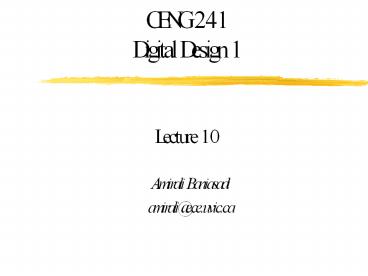CENG 241 Digital Design 1 Lecture 10 PowerPoint PPT Presentation
Title: CENG 241 Digital Design 1 Lecture 10
1
CENG 241Digital Design 1Lecture 10
- Amirali Baniasadi
- amirali_at_ece.uvic.ca
2
This Lecture
- Review of last lecture
- JK, T Flip-Flops
- Direct Inputs, Analysis of Clocked Sequential
Circuits
3
Graphic Symbols
4
Other Flip-Flops
- Each flip-flop is made of interconnection of
gates. - The edge-triggered D flip-flop is the most
efficient flip-flop since it requires the least
number of gates. - Other flip-flops are made using the D flip-flop
and extra logic. - Two flip-flops widely used are the JK and T
flip-flop.
5
JK Flip-Flop
- Three flip-flop operations Set, Reset,
Complement output. - JK performs all three
6
JK Flip-Flop
D JQ KQ if J1 , K0 then DQQ1 if
J0 , K1 then D0 if j 1 , K1 then D Q
7
T Flip-Flop
T (Toggle) flip-flop is a complementing one. T
flip-flop is obtained from a JK when inputs J and
K are tied together.
8
T Flip-Flop
If T0 ( JK0) output does not change. If T1 (
JK1) output is complemented. A T flip-flop can
also be made of D flip-flop and a XOR. D T XOR
Q TQ TQ
9
Characteristic Tables
- JK Flip-flop
- J K Q(t1)
- 0 0 Q(t) No change
- 0 1 0 Reset
- 1 0 1 Set
- 1 1 Q(t) Complement
10
Characteristic Tables
- D Flip-flop
- D Q(t1)
- 0 0 Reset
- 1 1 Set
- T Flip-flop
- T Q(t1)
- 0 Q(t) No change
- 1 Q(t) Complement
11
Direct Inputs
Some flip-flops have asynchronous inputs to force
the flip-flop to a particular state. Examples
Direct Set, Direct Reset. The input that sets
the flip-flop to 1 is called preset or direct
set. The input that clears the flip-flop to 0 is
called clear or direct reset. Works independent
of clock.
12
Direct Inputs Asynchronous Reset
When reset is 0, Q is forced to 1.
13
Analysis of Clocked Sequential Circuits
- Analysis Obtaining a table/diagram for the time
sequence of inputs/outputs/internal states. - Examples State Equations, State Table, State
Diagram
14
Analysis of Clocked Sequential Circuits
Example of state equation A(t1) A(t)x(t)
B(t)x(t) B(t1) A(t)x(t) A(t1)AxBx B(t1)
Ax y(t)(A(t)B(t)).x(t) (AB)x
15
Example of state tables
- Present state input Next
State Output - A B x A
B y - 0 0 0 0
0 0 - 0 0 1 0
1 0 - 0 1 0 0
0 1 - 0 1 1 1
1 0 - 1 0 0 0
0 1 - 1 0 1 1
0 0 - 1 1 0 0
0 1 - 1 1 1 1
0 0
State equation A(t1) A(t)x(t)
B(t)x(t) B(t1) A(t)x(t) y(t)(A(t)B(t)).x(t
)
16
Example of state tables-2nd form
- Present state Next State
Output - x0 x1
x0 x1 - AB AB AB
y y - 00 00 01
0 0 - 01 00 11
1 0 - 10 00 10
1 0 - 11 00 10
1 0
State equation A(t1) A(t)x(t)
B(t)x(t) B(t1) A(t)x(t) y(t)(A(t)B(t)).x(t
)
17
Example of state diagram
Present state Next State
Output x0
x1 x0 x1 AB
AB AB
y y 00 00
01 0 0 01
00 11
1 0 10 00
10 1 0
11 00 10
1 0
18
Analysis- D flip-flop
19
Analysis JK flip-flop
JAB KABx J Bx KBAxAx
20
Analysis JK flip-flop
A(t1)JAKA B(t1)JBKB A(t1)BA(Bx)A
ABABAx B(t1)xB(A XOR x)B
BxABxABx
21
Analysis JK flip-flop
Present state input Next State
A B x
A B 0 0
0 0 1
0 0 1
0 0 0 1
0 1 1
0 1 1
1 0 1 0
0 1 1
1 0 1
1 0 1 1
0 0 0
1 1 1
1 1
22
Analysis T flip-flop
Q(t1)TQTQ TABx TBx yAB A(t1)(Bx)A(B
x)A ABAxABx B(t1)x XOR B
23
Summary
- Analysis
- Reading up to page 206

